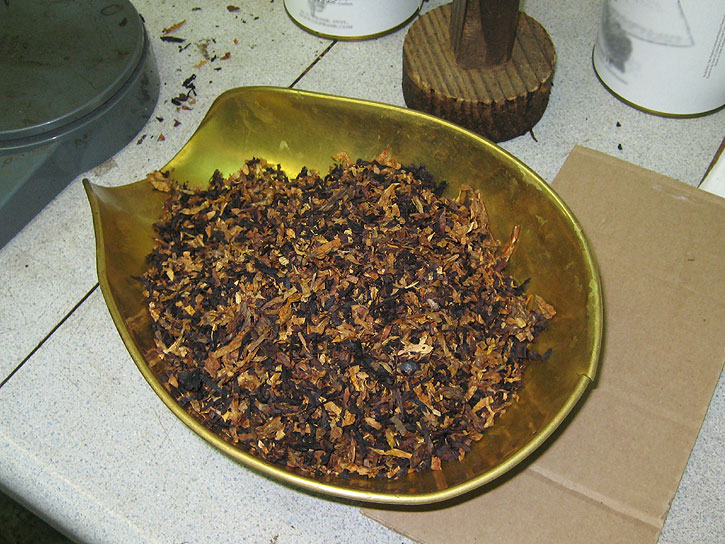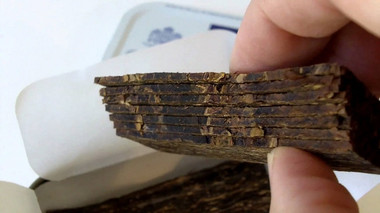Many people spend days, weeks or even months contemplating a pipe purchase, wanting to make sure they add the perfect piece to their collection; nothing less than perfection will suffice. How is it then that, comparatively speaking, the purchase of the tobacco itself is often rushed or not properly thought through. It doesn't make much sense, does it. While the pipe and the quality of its construction will undoubtedly have a considerable impact upon how much you enjoy your smoke, understanding the characteristics and the preparation techniques associated with the various types of pipe tobaccos is just as important. From shag to broken flake, rope to ribbon, there are many different cuts of tobacco and during this post we're going to talk about one of the most misunderstood: Flake pipe tobacco and give you a short run down of the post popular choice: Blended pipe tobacco.
Flake Pipe Tobacco: The Basics
Many pipe smokers give flake tobaccos a wide berth as they are unsure of just how they need to be approached in terms of preparation, therefore missing out on the zesty character and subtle sweetness that this type of tobacco is renowned for. You may also hear flake tobacco referred to as "slices" due to the way in which it is cut from compressed cakes, which are formed by exposing the tobacco to extreme pressure for an extended period. Leaving these tobaccos in this form allows them to hold onto their freshness and provides you, the smoker, with greater control over the burn rate and, to a less degree, the flavors that you enjoy. You'll usually find that these flakes are rectangular in shape, although sometimes that won't have such a definite form. The other thing that flake tobaccos are renowned for is their ability to age well; the taste often gets even better as the tobacco ages. All of this is fairly common knowledge, even among those that have, up to this point, steered clear of flake tobaccos. What you most probably want to know is how in the world you prepare it for smoking...
Preparing Flake Tobaccos: Some of the Best techniques
You can't just smoke flake tobacco like you do loose cut tobacco, that much is clear. There's a little more preparation that goes into it when you buy flakes, and just as there is more than one way to skin a cat (or so they say!), there's also more than one way to prepare flake tobacco and we're going to point out a few of our favorite techniques below. The technique that you use can and will affect the way in which it burns and also the taste of the tobacco. Believe it or not, the exact same flake tobacco can taste quite different when it is prepared in different ways.
- Fold and Stuff - This is possibly the most talked about method and the one that other flake pipe tobacco smokers will often advise you to use. The good news is that it's actually very straightforward to follow. You simply take one of the tobacco flakes and then, going against the grain, you double it over. You then need to double it over again, but this time bring one end towards the other, going with the grain of the tobacco. This is now ready to be loaded into the pipe of your choice. The flake will now appear as a kind of plug and this needs to be pushed down into the bowl of your pipe. Don't allow the flake to stick up past the rim of the pipe, as once you light up the rims will likely get charred and damaged. If the flake is too tall, simply pull it out and trim it with a pair of scissors. Another thing you would do well to remember is to leave a little bit of space between the tobacco and the rim. Due to it being compressed, when lit, the tobacco will swell a little, and this gap ensures the burn won't be affected.
- Roll and Stuff - This is very similar to the first method and the end result is similar too; some people just find rolling easier than folding. Again, take a tobacco flake, and then roll it length ways with the grain until the end. This plug is then pushed into the bowl in much the same way, taking the same precautions as with the last method (tobacco should not protrude past the rim and a space must be left between the tobacco and the sides of the bowl).
- Rubbing Out - Many times, the difference in taste when using the rubbing out method can be significant from the taste experienced with the very same tobacco that has been prepped using either of the two methods we've already discussed. The rubbing out method involves taking a tobacco flake and gently rubbing it between your palms, which causes it to break into smaller pieces. The intensity with which you carry out this action will influence the size of the pieces it produces, which can range from small (in the case of a full rub) to large (light rub). The tobacco can then be loaded in the same way as you would load a loose cut tobacco.
It's really a case of trial and error in terms of which method you should use. Some flake tobaccos are better when folded and stuffed, while rubbing out is a better way to release the flavors in others. Folding or rolling and stuffing will lead to a longer burn due to the greater density of the tobacco and many would say that this is the better way to smoke flake tobaccos that are older, darker and more complex in terms of their composition.
Know that we have covered Flake tobacco, lets talk about the other type of tobacco that is a little more common, Blended.
A SHORT GUIDE TO BLENDED PIPE TOBACCO
Many of the most popular pipe tobaccos on the market today are a blend of several different tobaccos rather than any single kind. This is hardly a new phenomenon though as the blending of tobaccos goes back centuries. Many tobacconists feature proprietary blends which they’ve been meticulously engineering for years and some are quite spectacular. In addition, scores of pipe smokers in countries near and far have tried their hand at developing their own distinctive blend or blends; ones that dovetail with their particular tastes, interests and personality. In this post we’ll look at the still somewhat mysterious world of blended pipe tobacco.
Why Blend Pipe Tobacco?

Pipe smoking is a different animal than cigar or cigarette smoking. Tobacco in a bowl is going to be packed differently, burn differently, activate different pleasure centers of the brain and leave a different impression in the air than either a cigar or cigarette. The enjoyment of pipe tobacco is in fact a three stage process that can be heavily influenced by the blend. Those stages being:
- The appreciation of the tobacco’s aromatic qualities prior to smoking.
- The enjoyment of the subtle aspects of the tobacco’s flavor and aroma during the smoke.
- The ability of the tobacco to generate a pleasing environmental effect that lingers once the bowl is spent.
Successful tobacco blending requires an understanding of and ability to balance these factors as well as a fundamental knowledge of the characteristics of different tobaccos.
Some of the Most Popular Types of Tobacco and Their Characteristics
There isn’t room to list all the different types of tobacco here but most blends are typically composed of two or more of the following types:
- Burley - Burley is arguably the most popular type of pipe tobacco in the world today and the tobacco upon which more blends are based than any other. It’s an earthy, flavorful tobacco that’s easily identified by its distinctive light brown color. Burley is known for being a cool smoke which is another attribute that makes it a perfect blending tobacco.
- Latakia - Latakia is a product of the eastern Mediterranean, in particular Cyprus and Syria. Latakia is famous for its campfire-like, smoky aroma and is something of a contradiction because it’s also a cool smoke. Far from being a weakness however many people find this contradiction makes Latakia an ideal blending tobacco.
- Perique - Perique is grown only in Saint James Parish outside New Orleans and is fermented for a year after harvesting. It’s slightly fruity, slightly pungent, slightly peppery characteristics can shift, so if you’re using Perique to create a blend you’ll likely need to alter the amounts you use from batch to batch to achieve consistent results.
- Virginia - Virginia will give Burley a run for its money when it comes to being a popular base for different blends. It’s commonly used in everything from Oriental blends to various aromatic mixtures and even some English blends. The high sugar content of Virginia tobacco means it’ll burn slightly hotter than Latakia or Burley.
- Turkish - “Turkish” can be a bit of a misnomer as it’s come to cover a number of different tobaccos grown not just in Turkey but in other regions of the Middle East and Eastern Europe as well. Turkish tobaccos are a common ingredient in many cigarette blends due to their fast burning yet mild characteristics.
Some Examples of Blended Pipe Tobacco
Here are some of the most popular types of blended pipe tobacco available today.
- English - Almost any contemporary blend that eschews added flavorings is referred to as “English”, whether or not it’s actually a product of England. English blends typically feature Latakia, Virginia and perhaps Perique tobaccos.
- Virginia - There are few hard and fast rules when it comes to which tobaccos can be used to produce the Virginia blend, as long as Virginia tobacco is dominant. The one exception being that spice tobaccos should be kept to a minimum.
- Aromatics - Aromatic blends are typically a blend of Burley and Virginia tobaccos with vanilla, cherry, whiskey, rum and other flavors added after the fact. Most of the best selling brands of pipe tobacco are aromatic blends.
- Burley - Burley blends are built around a dominant foundation of Burley tobacco with other tobaccos added in discrete measure. A Burley blend also utilizes flavor enhancers ala Aromatic blends although in reduced quantities.
- Oriental - An Oriental blend is just that; a blend built around Turkish or other Oriental tobaccos with Virginias, Burleys and other tobaccos taking a secondary role. Latakia is sometimes used as well but is usually less than 10% of the final mix.
While the tobacco types and blends presented here have gained widespread recognition and popularity there’s nothing stopping you from engaging in some pipe tobacco alchemy of your own. Once you have the perfect flake or blend ready to go make sure you enjoy it in a beautiful meerschaum or briar pipe from Paykoc Imports!

 US Dollars
US Dollars
